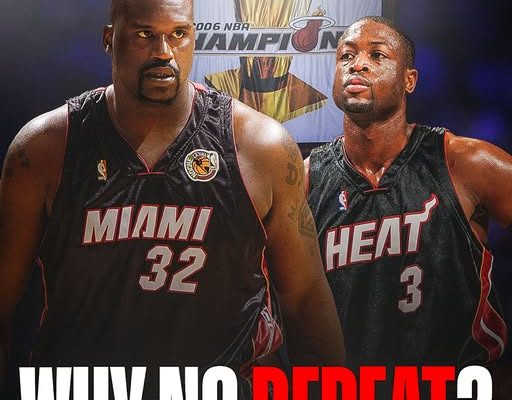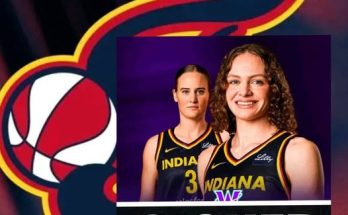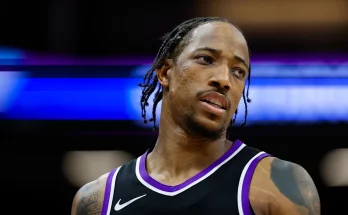The 2006 Miami Heat represent one of the most captivating stories in NBA history—a team that reached the very pinnacle of success with a perfect blend of talent, leadership, and timing, only to see that glory fade faster than many expected. Their rise was meteoric, fueled by the electrifying play of a young superstar, the dominance of a seasoned champion, and the steely hand of one of basketball’s most revered coaches. Yet, despite their championship, the team’s legacy would not be one of a dynasty but rather a moment in time that underscored the fragile nature of greatness in professional sports.
When Shaquille O’Neal and Dwyane Wade first joined forces for the Miami Heat, expectations were high but tempered. Shaq was a proven winner, having already secured three NBA championships during his time with the Los Angeles Lakers, and Wade was a rising star with explosive athleticism and an insatiable competitive drive. Pat Riley, the architect behind the Heat’s transformation from an average team into a championship contender, was relentless in his pursuit of a title. His leadership created a culture of discipline, toughness, and championship ambition that permeated the locker room. This unique combination of veteran experience, youthful energy, and coaching excellence laid the foundation for what would become a historic season.
The 2005-2006 season saw the Heat craft a perfect storm. Shaq brought his imposing presence in the paint, bullying defenses with his size and strength, while Wade dazzled with his speed, creativity, and scoring prowess. The supporting cast, though often overshadowed by the star duo, played critical roles—players like Antoine Walker and Jason Williams contributed valuable minutes, while Udonis Haslem’s grit and determination provided an emotional backbone. As the season progressed, the team gelled at the right moments, building chemistry that allowed them to overcome challenges and adversity.
Wade’s performance in the playoffs was nothing short of legendary. He elevated his game to a level that defined his career, leading Miami through a grueling postseason that culminated in a dramatic NBA Finals victory over the Dallas Mavericks. His combination of clutch scoring, fearless drives to the basket, and defensive tenacity earned him the Finals MVP award and cemented his place among basketball’s elite. Shaq, for his part, added a fourth championship ring to his collection, demonstrating that even in the later stages of his career, he remained a dominant force on the court.
This title was more than just a trophy; it was a defining moment for the Miami Heat franchise. Before 2006, Miami had been a middling team, frequently overshadowed by larger markets and more storied franchises. This championship was proof that the Heat could compete with the NBA’s best, setting a precedent for future success and planting the seeds for a culture of winning that would become synonymous with the franchise. The fans celebrated, the city rejoiced, and the basketball world took notice.
Yet, beneath the surface of this triumph was an unspoken truth: the 2006 Miami Heat were not built to last. Their championship run was a convergence of talent and circumstance unlikely to be replicated. The next season brought a harsh reality check. Injuries struck with brutal force—Shaq’s dominance waned as his body aged and wear and tear took its toll, while Wade battled shoulder issues that limited his effectiveness. The supporting cast failed to maintain the level of contribution necessary to sustain championship success, and the once-tight chemistry began to unravel.
By the 2007 playoffs, the defending champions faced a hungry and revitalized Chicago Bulls team. Expectations were high for a fierce defense of their title, but the Heat’s resolve was broken. They were swept in the first round, a quiet and disappointing exit that spoke volumes about how quickly fortunes can change in the NBA. The energy and fire that had carried them to the mountaintop the previous year were absent. There was no fight left in this team, no hunger to reclaim their throne.
This swift downfall was a reminder that winning an NBA championship requires more than just star power and coaching—it demands durability, depth, and a sustained hunger for greatness. The 2006 Miami Heat, for all their brilliance, were a team caught in the perfect moment, but unable to build a lasting legacy. Their story is not one of dynasty or prolonged dominance but of a fleeting flash of greatness that captured the imagination of fans and gave Miami its first taste of basketball immortality.
Looking back, the 2006 championship remains a cherished memory for Heat fans, a shining example of what can be achieved when talent and leadership align. It also serves as a cautionary tale about the ephemeral nature of sports glory. Teams come together, reach incredible heights, and then disperse—sometimes leaving behind only a ring and a story of what once was. For the Heat, that 2006 title was everything at the time, a singular achievement that brought validation and pride to the franchise and its supporters.
In the years that followed, Miami would strive to recapture that magic, learning from the challenges of 2007 and beyond. The lessons of that championship season—the importance of building a resilient roster, managing injuries, and maintaining championship-level intensity—would shape the Heat’s future approach. Though the original 2006 team never returned to the mountaintop, the spirit of that title run lived on, inspiring new generations of players and fans alike.
In conclusion, the 2006 Miami Heat were a perfect storm of greatness that reached the NBA’s summit but never stayed there. They remain a symbol of a moment when everything aligned to create a championship, a testament to the power of teamwork, leadership, and the relentless pursuit of victory. Their legacy is not one of lasting dominance but of a singular, unforgettable flash of brilliance—one that reminds us that sometimes, a single ring can mean everything.



